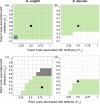Coevolutionary transitions from antagonism to mutualism explained by the Co-Opted Antagonist Hypothesis
- PMID: 34001894
- PMCID: PMC8129128
- DOI: 10.1038/s41467-021-23177-x
Coevolutionary transitions from antagonism to mutualism explained by the Co-Opted Antagonist Hypothesis
Abstract
There is now good evidence that many mutualisms evolved from antagonism; why or how, however, remains unclear. We advance the Co-Opted Antagonist (COA) Hypothesis as a general mechanism explaining evolutionary transitions from antagonism to mutualism. COA involves an eco-coevolutionary process whereby natural selection favors co-option of an antagonist to perform a beneficial function and the interacting species coevolve a suite of phenotypic traits that drive the interaction from antagonism to mutualism. To evaluate the COA hypothesis, we present a generalized eco-coevolutionary framework of evolutionary transitions from antagonism to mutualism and develop a data-based, fully ecologically-parameterized model of a small community in which a lepidopteran insect pollinates some of its larval host plant species. More generally, our theory helps to reconcile several major challenges concerning the mechanisms of mutualism evolution, such as how mutualisms evolve without extremely tight host fidelity (vertical transmission) and how ecological context influences evolutionary outcomes, and vice-versa.
Conflict of interest statement
The authors declare no competing interests.
Figures





References
-
- Bronstein, J. L. Mutualism. (Oxford University Press, UK, 2015).
-
- Weiblen, G. & Treiber, E. Evolutionary origins and diversification of mutualism. in Mutualism (ed. Bronstein, J) 37–56 (Oxford University Press UK, 2015).
Publication types
MeSH terms
LinkOut - more resources
Full Text Sources
Other Literature Sources

